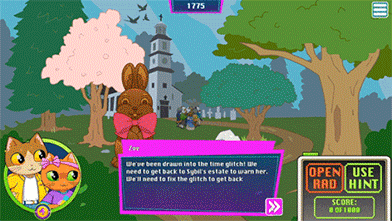Time Tails is a series of puzzle adventure games that is designed to teach players coding concepts and how to use game design software. The game follows 80’s kids Ari and Zoe as they travel through time and fix “glitches” in history using game programming and design concepts. The chapters in Time Tails were designed by educators for a 9th grade level of education. Episode 1 of Time Tails is available on Steam for both Windows and MacOS.
During my time at Snowbright Studio, I worked as a junior game developer. I was assigned to the technical team and began working on Time Tails from the ground up. I contributed to Time Tails as the main Unity developer, implementing core game mechanics and Some areas I worked in developing dialogue system events, UI events, and other UI functionality. Time Tails was made in the Unity game engine with art assets being created by creative manager Quill Kolat.
About the studio and the game
While developing the game, Snowbright Studio worked with Games for Change, Unity, Entertainment Software Association (ESA), and the US Department of Education’s SBIR program. Snowbright’s mission is that every student should be a part of solving the biggest challenges of today and tomorrow, and that games can be a pathway to achieving that goal. Time Tails was a game that was built with the invention of softly introducing Unity concepts to children, making the game engine less intimidating to use when they get to it. Snowbright Studio ran a pilot study with four schools to see how students would respond to the game and what information they can take away from that. Founder and CEO Grace Collins and creative manager Quill Kolat presented a talk on Time Tails and gender equity in game development at Games For Change 2021.
My contribution
I began building the game early on during my time at Snowbright Studio. I began by working on the main mechanic of the game - the RAD menu. In the game, the RAD menu is the user’s main method of interacting and manipulating the 2D environment. I began with a simple scene to practice moving a pair of 2D sprites along the X and Y axis given two input fields and an “apply” button.
After that was functional, I created a RAD prefab that I would then bring into the first scene of the game. I then tweaked it visually and functionally as I continued development. For example, I found that if a user were to input a large float value into the RAD menu, it could translate the object off screen, keeping the user from being able to complete the goals of the level. I then established a boundary around what the user can see, choosing two X values for the each side of the scene and two Y values for the top and bottom of the screen. I chose points slightly off screen, allowing the user the ability to move a gameobject slightly off screen, but would prevent them from completely moving the gameobject off screen. This way, the user can still move those objects to the side, but won’t make them completely inaccessible.
The first episode of Time Tails focused on translating objects along the X, Y and Z axis. Given that the game was 2D, the Z axis transform was faked by adjusting the size of the gameobject to mimic depth of the scene. I then established a limit to how far “back” or “forward” the object can be moved based on the scene. I would then present errors in relation to the scene. For example, “ERROR: Object is at the end of the ship!” The scale and rotation were then added to the RAD menu in episode 2 of Time Tails.
I also worked on creating the dialogue system events that occurs throughout the game. We used the tool Dialogue System tool developed by Pixel Crushers. I modified the prefabs to work around what was needed for Time Tails. I created databases for dialogues and modified certain dialogues to adjust to player action. For example, if a player moved Gameobject C first instead of Gameobject B, the dialogue would be adjusted.

